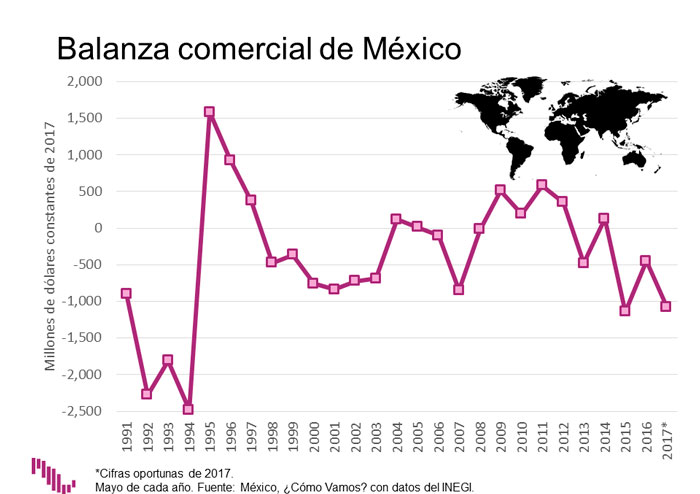What is the Mexico’s trade balance, what it is used for and what entity makes it, are all important questions for you when you are engaged in foreign trade, you are interested in exporting or importing products and you want to know how the balance has closed and based on this you will obtain a more clarified panorama product that will generate a greater profit in your business.
What is and what is the Mexican trade balance for?
- The Mexico’s trade balance which is commonly known by the acronym BCMM, in principle it serves because from the data it provides it is possible to have a broad vision of the amount and value of imports and exports made by Mexico and which are the countries that participate in this type of foreign trade.
- What entity makes it? Well, the INEGI, National Institute of Statistics and Geography, is in charge of its elaboration.
- You basically know what it is, what it is for and who makes it, but who uses it? It is used by both the private and public sectors of Mexico and by national and international institutions.
- It is very useful because it reflects whether there is a balance between transactions, that is, between imports and exports.
- In fact, the balance shows a balance based on a subtraction between exports and imports.
- Therefore that balance can reflect both a surplus and a deficit. It will reflect a surplus when the balance indicated that exports exceeded imports. On the contrary, it will reflect a deficit when imports exceeded exports.
- In short, it provides a statistic that clearly shows what the economic openness of Mexico is and at the same time shows what the impact suffered by companies after the signing of trade agreements has been.
- INEGI has a governing board that highlighted the role of the trade balance as information of national interest because it offers assistance to institutional work. by providing important statistical information for the private and public commercial sectors.
What does Mexico’s trade balance indicate in the last 5 years?
Reports related to Mexico’s trade balance in the last 5 years, from 2013 to 2018 indicate that:
- In 2013 the balance closed with a deficit of 1009 million dollars, which detected a growth in the deficit that was registered in 2012.
 The deficit was due to an increase in imports over exports, since exports amounted to 3802101 million dollars while imports amounted to 391201 million dollars.
The deficit was due to an increase in imports over exports, since exports amounted to 3802101 million dollars while imports amounted to 391201 million dollars.
- In 2014 the balance closed with a surplus that reached 254 million dollars with a commercial exchange of exports corresponding to 34,114.7 million dollars and imports for a total of 33,860.7 million dollars.
The balance showed at the same time that the commercial exchange registered 8 months of the year 2014 of positive numbers and a recovery compared to the previous month that had fallen with a negative figure of 1076.4 million dollars.
Likewise, the report indicates that of the total exports, 92.8% were non-oil transactions equal to 31,647.1 million dollars and 7.2% to oil exports, which corresponds to 2,467.6 million dollars.
In the month of December 2014, 62.1% of the exported products were manufactures, divided into automotive manufactures 26.4%, agricultural products 3.2%, crude oil 5.9%, products that correspond to the extractive sector 1.1% and derivatives of the oil 1.3%
Regarding imports, 89.8% of oil origin amounted to 30422.3 million dollars, 14.5% correspond to consumer goods, 10.9% to capital goods and 74.5% to purchase of intermediate goods.
- Contrary to what happened in 2014, the balance for 2015 indicates that it closed with a trade deficit that reached 927 million dollars according to what was reported by the National Institute of Statistics and Geography.
The negative balance of 14,460 million dollars that was observed in the month of December was due to the fact that in October oil exports fell by 41.5%, with exports reaching 30,961 million dollars, integrated with non-oil exports of 29,747 million of dollars.
Annual decreases in imports by type of good fell by 1.9%, those of consumer goods, intermediate-use goods by 7% and capital goods by 3%
- In 2016, the balance closed with a deficit of 13 135 million dollars, a deficit that did not reach what was reported in 2015, that is, the deficit was reduced due to non-oil products than in 2015 were 4,495 million dollars while in 2016 they were 312 million dollars.
Even oil products in 2015 reached a figure of 10,115 million dollars and in 2016 they reached 12,823 million dollars.
Only in the month of December the balance showed a surplus that reached 28 million dollars compared to the 200 million dollars of surplus in the month of November and a deficit in 2015 of 715 million dollars.
Exports in the month of December grew to a figure of 33,232 million dollars, fisheries and agricultural exports increased by 11.9%, extractive by 2.1% and manufacturing by 4.6%
- In 2017 the balance registered a deficit that reached 10,875 million dollars, while in December 2017 the deficit was 11 million dollars.
- Finally, the balance for the year 2018 registered a surplus that reached 1,836 million dollars due to the exhortation of the automotive sector and national manufacturing, while exports from the oil sector continue with a continuous negative pressure.
In December, exports registered 37,529 million dollars, a value higher than that registered in December 2017, while imports increased to 35,693 million dollars.
